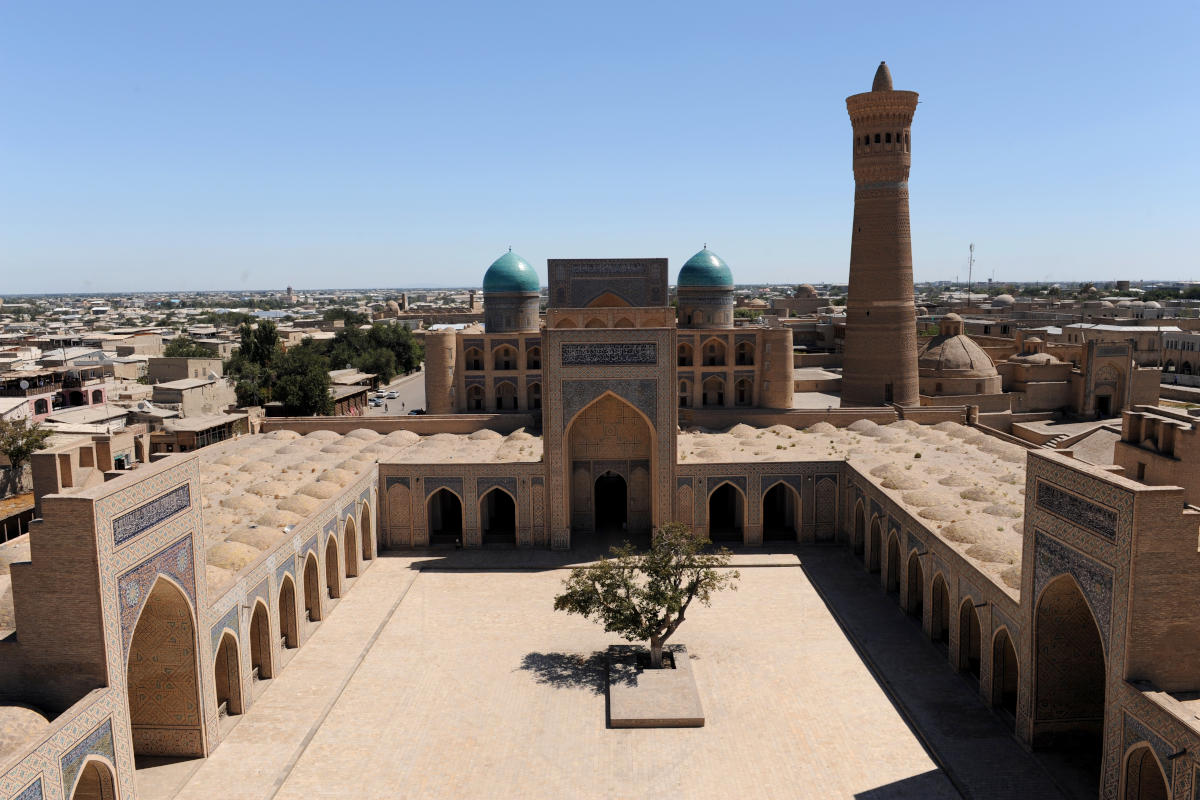Bukhara - Kalon Mosque

The Kalon Mosque in Bukhara – a masterpiece of Islamic architecture
The Kalon Mosque in Bukhara is one of the most impressive religious buildings in Central Asia and has existed for more than 500 years. It has always served as the city’s main mosque and is a dome mosque (cathedral) or Friday mosque (Juma mosque). Devout Muslims gather here at lunchtime on Fridays to pray together (namaz). The mosque is extremely spacious and can accommodate up to 12,000 people at a time.
The architectural ensemble around the Kalon Mosque
Situated at the foot of the Kalon Minaret, the mosque forms a monumental architectural ensemble together with the Mir-Arab Medrese. Together with the small square between them, they form a unified complex called Poi Minar (‘at the foot of the minaret’).
Behind the Mir Arab Madrasah, at the Zargaron bazaar dome, there is another ensemble with the Ulugbek and Abdulaziz Khan Madrasahs, an old crossroads of Shahristan. To the south are two more historic bazaar domes, Toki Telpak-Furushon and Toki Sarrofon.
To the north rises the mighty Ark Citadel, next to it to the east is the Emir’s prison (Zindan). The Kalon Mosque is one of the most important buildings in this impressive ensemble.
Historical significance and construction
The mosque was built in 1514 during the reign of Ubaydulla Khan from the Shaybanid dynasty. It is considered to be one of the oldest and is the second largest mosque in Central Asia after the Bibi-Khanum Mosque in Samarkand. In the 16th century, Bukhara became the capital of an important empire, resulting in the construction of numerous imposing buildings. The Kalon Mosque was built on the foundations of an earlier main mosque, which was built in the 12th century under the Karakhanid dynasty and destroyed during the conquest by Genghis Khan. Remains of this first mosque, in particular fragments of the lower masonry, are still preserved.
Some historians believe that the main mosque was in a different location before the 12th century and was moved to its current location as part of a restructuring of the city centre of Bukhara.
Architectural features
The architecture of the Kalon Mosque is based on the building traditions of the Temurid period. It is a rectangular structure with four aivans (entrance halls). The main entrance is located on the east side and is decorated with a magnificent mosaic portal and Arabic inscriptions. A staircase leads to the spacious inner courtyard.
A large, blue double dome rises above the central hall with its cruciform floor plan. The outer dome rests on an artistically designed drum of mosaics. Further blue domes adorn the side wings of the main building. To the west of the mosque is the mihrab, the prayer niche, which indicates the direction to Mecca and is decorated with magnificent mosaics.
The rectangular inner courtyard is surrounded by galleries consisting of 288 domes on 208 columns. The entire building covers an area of one hectare. The Kalon Mosque is an open mosque, so worshippers can pray both in the inner courtyard and in the covered galleries.
Special elements and materials
The mosque was built from burnt bricks, stone and wood. The façades are made of artistically arranged bricks and are decorated with light-coloured mosaics, blue and white glazing and Arabic calligraphy. The name of the master builder, Bayazid al Purani, has been incorporated into the façade as an ornament. Inside, the walls are decorated with filigree ornaments and gilded Koranic verses.
The tomb of one of the first imams of the Kalon Mosque is located in the inner courtyard. At the beginning of the 20th century, an eight-sided pavilion was built over the tomb, which served as a pulpit. Thanks to the excellent acoustics, thousands of worshippers were able to listen to the sermons.
Particularly noteworthy are the vaulted galleries, which have a cooling effect in high temperatures and provide shade for the faithful.
Restoration and current use
 The Kalon Mosque was extensively restored at the end of the 20th century and is still in use today. Access for tourists is not permitted during Friday prayers. On other days, the mosque is closed to visitors from 20:00 to allow space for the prayers of the faithful.
The Kalon Mosque was extensively restored at the end of the 20th century and is still in use today. Access for tourists is not permitted during Friday prayers. On other days, the mosque is closed to visitors from 20:00 to allow space for the prayers of the faithful.
The Kalon Mosque is one of the most important historical landmarks in Bukhara and an impressive example of Islamic architecture in Central Asia.
